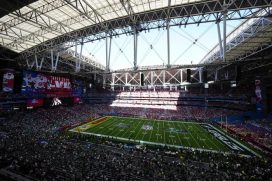The Philadelphia Eagles most surprising move during the 2014 NFL Draft weekend was not the drafting of first round pick Marcus Smith, but rather the return they received from the Buffalo Bills for backup running back Bryce Brown. On the final day of the draft, the Eagles and Bills completed a trade that netted the Eagles a conditional 4th round pick in the 2015 draft as well as a swap of 7th round selections in the 2014 draft. So what exactly does the trade of Brown mean for the Eagles?
Well first of all, it means that we Eagles fans are all now big fans of San Francisco 49ers receiver Stevie Johnson. The draft pick that the Birds acquired from Buffalo is originally San Francisco’s pick, which Buffalo acquired in a draft day deal with San Francisco. As it stands right now, the Eagles will receive a 2015 fourth round pick for Brown, but it can turn into a 2016 third round selection or 2016 fourth round selection.
Confusing, right? Okay, let’s move on to what this means for the Eagles.
Here is what we know about the Eagles: They have potentially the best running back in football in LeSean McCoy. They traded a 5th round pick to New Orleans for Darren Sproles and have incumbents Chris Polk and Matthew Tucker waiting in the wings. So the question becomes, where does the bulk of Brown’s carries go?
The obviously response is Darren Sproles, but I do not believe the shifty back will receiver as many carries as we may be led to think. The change-of-pace back only carried the ball 53 times last season and has never had more than 93 carries in a season. The Eagles will want to use diminutive running back in dual back sets with McCoy to get both open in space. Where the Eagles will utilize Sproles most is in the slot and coming out of the backfield. In his career, the former Saint has caught 378 passes, including a career high 86 in 2011 and 71 last season.
As I mused earlier in the offseason, Chris Polk was preparing for an important role with the Eagles in year three. In limited action, Polk ran for three touchdowns and averaged 8.9 yards per carry. He was also strong catching the ball and showed a penchant for attacking holes and not bouncing outside. Health has always been a concern for the former Washington Huskie, but if he can stay healthy, he will be in line for many of Brown’s carries. Former Eagledelphia.com editor and current NJ.com writer Matt Lombardo looked at the possibilities Polk’s chances of being McCoy’s primary backup.
This now brings us to Matthew Tucker. Tucker spent part of last season on the Eagles practice squad prior to Polk’s injury. Tucker was elevated to the active roster and saw playing time in two games. Although he did not receiver a carry, Tucker is a big running back (6-1, 227) that is willing to play special teams.
So here is where we stand two days after the 2014 NFL draft. In trading Brown, the Birds were able to trade from a position of surplus to gain more draft picks for the future. After McCoy led the NFL in yards rushing and carries, the team appears comfortable enough with their moves of providing extra help for Shady by bringing in Sproles and relying on incumbents Polk and Tucker. Despite the trade, the Eagles still have an absurdly talented group of running backs that are multi-talented and all bring difference dynamics to the unit.
Hal Greenblatt covers the Eagles for Eagledelphia. Follow him on Twitter: @HMGreenblatt







